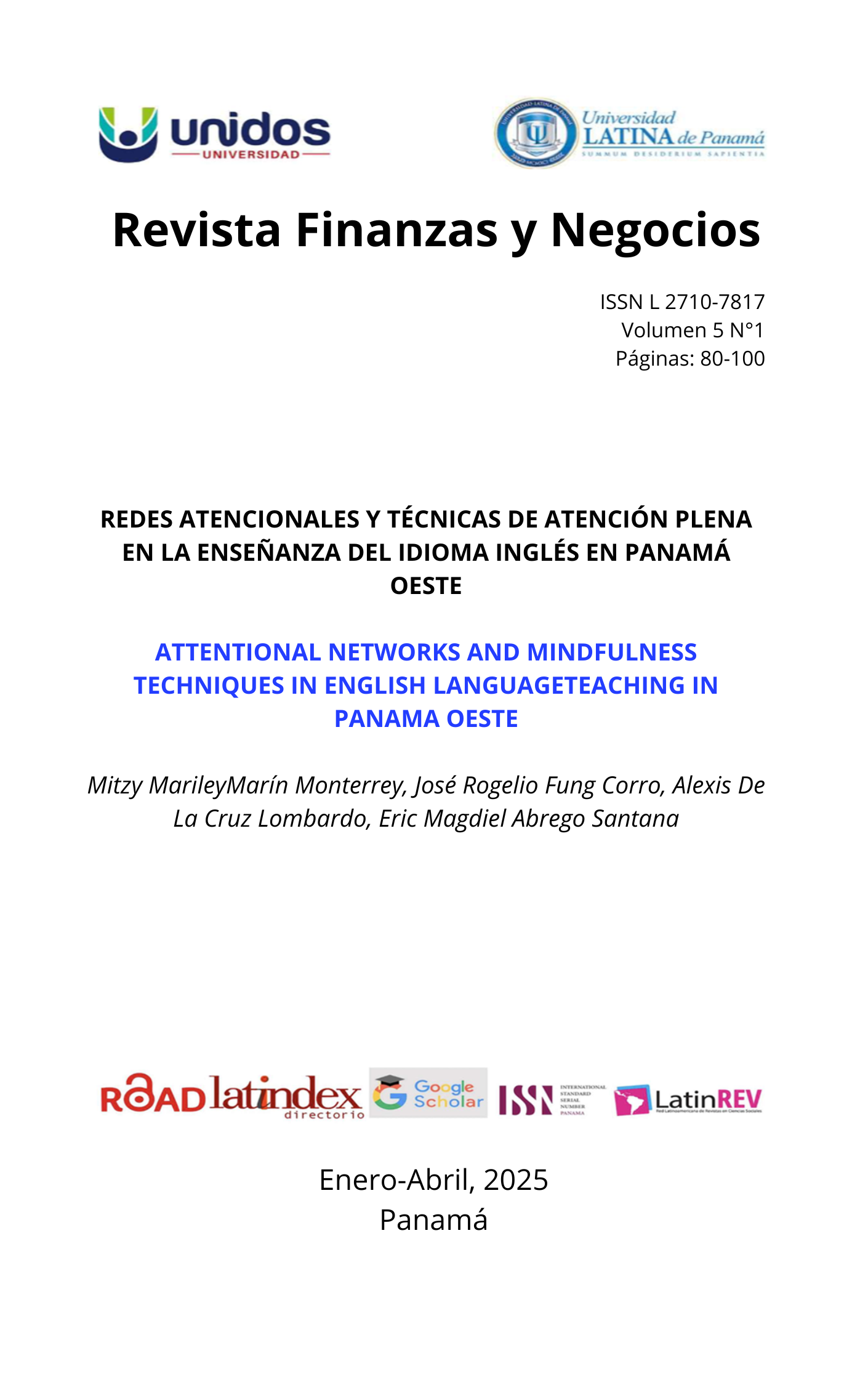Attentional Networks and Mindfulness Techniques in English Language Teaching in Panama Oeste
Keywords:
Cognitive attention, mindfulness techniques, English teaching, student motivation, active participation, innovative educationAbstract
This study researches the effectiveness of attentional networks and mindfulness techniques in teaching English in Panamá Oeste, addressing the challenges faced by students in a heterogeneous educational context. The main purpose is to improve students’ attention and active participation through the implementation of innovative teaching strategies. A non-experimental design was used with five groups of approximately 150 students at basic to intermediate levels, applying mindfulness activities at the beginning of each class. The results showed a significant positive correlation (r = 0.991) between the practice of mindfulness and linguistic performance, with a significance level of p < 0.05. Although the differences in the means of the pretest and posttest did not reach statistical significance, a trend towards improvement in linguistic skills was evident. Additionally, a high percentage of students reported feeling more motivated and confident when participating in group activities. The conclusions highlight the importance of integrating attentional networks and mindfulness in English teaching, suggesting that these methodologies can enhance learning and the overall development of students.
Downloads
References
Asociación Nacional de Psicología Evolutiva y Educativa de la Infancia, Adolescencia y Mayores España. https://www.redalyc.org/pdf/3498/349832320025.pdf
Badia, A. (2024). Mindfulness: qué es y cómo se practica. Psicología-Online. https://www.psicologia-online.com/mindfulness-que-es-y-como-se-practica-4616.html#anchor_0
Bauzá & Fernández (2009). Adolescencia y desarrollo emocional en la sociedad actual.
Chao, Li. (2024). Joint analysis of interaction and psychological characteristics in english teaching based on multimodal integration. BMC Psychology, 12 doi: 10.1186/s40359-024-01585-0 https://typeset.io/papers/joint-analysis-of-interaction-and-psychological-pnxfcr35bk
Emotional Intelligence: Why It Can Matter More Than IQ (10th anniversary ed.). Bantam Books. – Search Videos. (2014). https://www.bing.com/videos/riverview/relatedvideo?q=Emotional%20Intelligence:%20Why%20It%20Can%20Matter%20More%20Than%20IQ%20
(10th%20anniversary%20ed.).%20Bantam%20Books.%20&mid=F56C5BEA0379A68897D2
F56C5BEA0379A68897D2&ajaxhist=0
Guoxing, Yu. (2023). Design of Intelligent Interactive Teaching System for College English Based on Streamlined Bilinear Attention Networks. Applied mathematics and nonlinear sciences, 9(1) doi: 10.2478/amns-2024-1025 https://typeset.io/papers/design-of-intelligent-interactive-teaching- system-for-4ipcq11x0u
J. Li. (2024). Diseño y aplicación de la evaluación de la calidad de la enseñanza del inglés basada en la web mediante un mecanismo de atención suave con una red neuronal de retropropagación, Conferencia Internacional sobre Ciencia de Datos y Seguridad de Redes (ICDSNS) de 2024, Tiptur, India, pp. 1-4, doi: 10.1109/ICDSNS62112.2024.10691189 https://ieeexplore.ieee.org/abstract/document/10691189
Kolb, B., & Whishaw, I. Q. (2003). El cerebro y la conducta. Editorial Médica Panamericana.
López, J. P. P. (2021). La atención: tres redes del modelo neurocognitivo - Smartick. Smartick. https://www.smartick.es/blog/padres-y-profesores/psicologia/una-breve-descripcion-la-atencion/
Vergara et al., (2024). Inteligencia Emocional y su Incidencia en el Rendimiento Académica de Estudiantes de Básica Media. Ciencia Latina: Revista Multidisciplinar, ISSN-e 2707-2215, ISSN 2707-2207, Vol. 8, Nº. 3, 2024, págs. 7274-7287 https://dialnet.unirioja.es/servlet/articulo?codigo=9787174
Xi, L. (2024). Identification of English Teaching Effectiveness and Students’ English Proficiency Development in Colleges and Universities Combining Refined Bilinear Attention Networks. Applied Mathematics and Nonlinear Science, Sciendo, vol. 9 no. 1, https://doi.org/10.2478/amns-2024-0779
Zeng, S., Zhang, J., Gao, M., Xu, K. M., & Zhang, J. (2020). Using learning analytics to understand collective attention in language MOOCs. Computer Assisted Language Learning, 35(7), 1594–1619. https://doi.org/10.1080/09588221.2020.1825094

Downloads
Published
How to Cite
Issue
Section
License
Copyright (c) 2025 Mitzy Mariley Marín Monterrey , José Rogelio Fung Corro , Alexis De La Cruz Lombardo , Eric Magdiel Abrego Santana

This work is licensed under a Creative Commons Attribution-NonCommercial-ShareAlike 4.0 International License.
El contenido de las publicaciones son responsabilidad absoluta de los autores y no de la Universidad ni de la revista Finanzas y Negocios, que es editada por la Universidad UNIDOS. La revista permite a los autores mantener el derecho de autor sobre los articulos y documentos publicados mediante el uso de la siguiente licencia.
Los artículos se publican con una licencia https://creativecommons.org/licenses/by-nc-sa/4.0/deed.es
Bajo los siguientes términos:
-
Atribución — Usted debe dar crédito de manera adecuada, brindar un enlace a la licencia, e indicar si se han realizado cambios. Puede hacerlo en cualquier forma razonable, pero no de forma tal que sugiera que usted o su uso tienen el apoyo de la licenciante.
-
NoComercial — Usted no puede hacer uso del material con propósitos comerciales.
-
CompartirIgual — Si remezcla, transforma o crea a partir del material, debe distribuir su contribución bajo la misma licencia del original.

